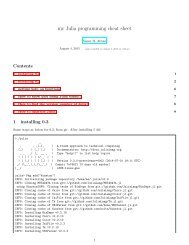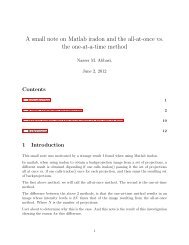You also want an ePaper? Increase the reach of your titles
YUMPU automatically turns print PDFs into web optimized ePapers that Google loves.
17 Misc. items<br />
The Jacobian matrix for a system of differential equations, such as<br />
is given by<br />
x ′ (t) = f (x, y, z)<br />
y ′ (t) = g (x, y, z)<br />
z ′ (t) = h (x, y, z)<br />
⎛<br />
J =<br />
⎜<br />
⎝<br />
For example, for the given the following 3 set of coupled differential equations in n 3<br />
df<br />
dx<br />
dg<br />
dx<br />
dh<br />
dx<br />
df<br />
dy<br />
dg<br />
dy<br />
dh<br />
dy<br />
df<br />
dz<br />
dg<br />
dz<br />
dh<br />
dz<br />
x ′ (t) = −y (t) − z (t)<br />
y ′ (t) = x (t) + ay (t)<br />
⎞<br />
⎟<br />
⎠<br />
z ′ (t) = b + z (t) (x (t) − c)<br />
then the Jacobian matrix is<br />
⎛<br />
⎞<br />
0 −1 −1<br />
J =<br />
⎜ 1 a 0<br />
⎟<br />
⎝<br />
⎠<br />
z (t) 0 x (t) − c<br />
Now to find stability of this system, we evaluate this matrix at t = t 0 where x (t 0 ) , y (t 0 ) , z (t 0 ) is a point in<br />
this space (may be stable point or initial conditions, etc...) and then J become all numerical now. Then we can<br />
evaluate the eigenvalues of the resulting matrix and look to see if all eigenvalues are negative. If so, this tells us<br />
that the point is a stable point. I.e. the system is stable.<br />
If X is N(0, 1) distributed then mu + sigma ∗ X is N(mu, sigma 2 ) distributed.<br />
64





